ECSE 1010 Proof of Concepts - Omega Lab01
0. Lab Document
1. Prove Ohm’s Law, KCL, and KVL in a Circuit
Circuit Schematic
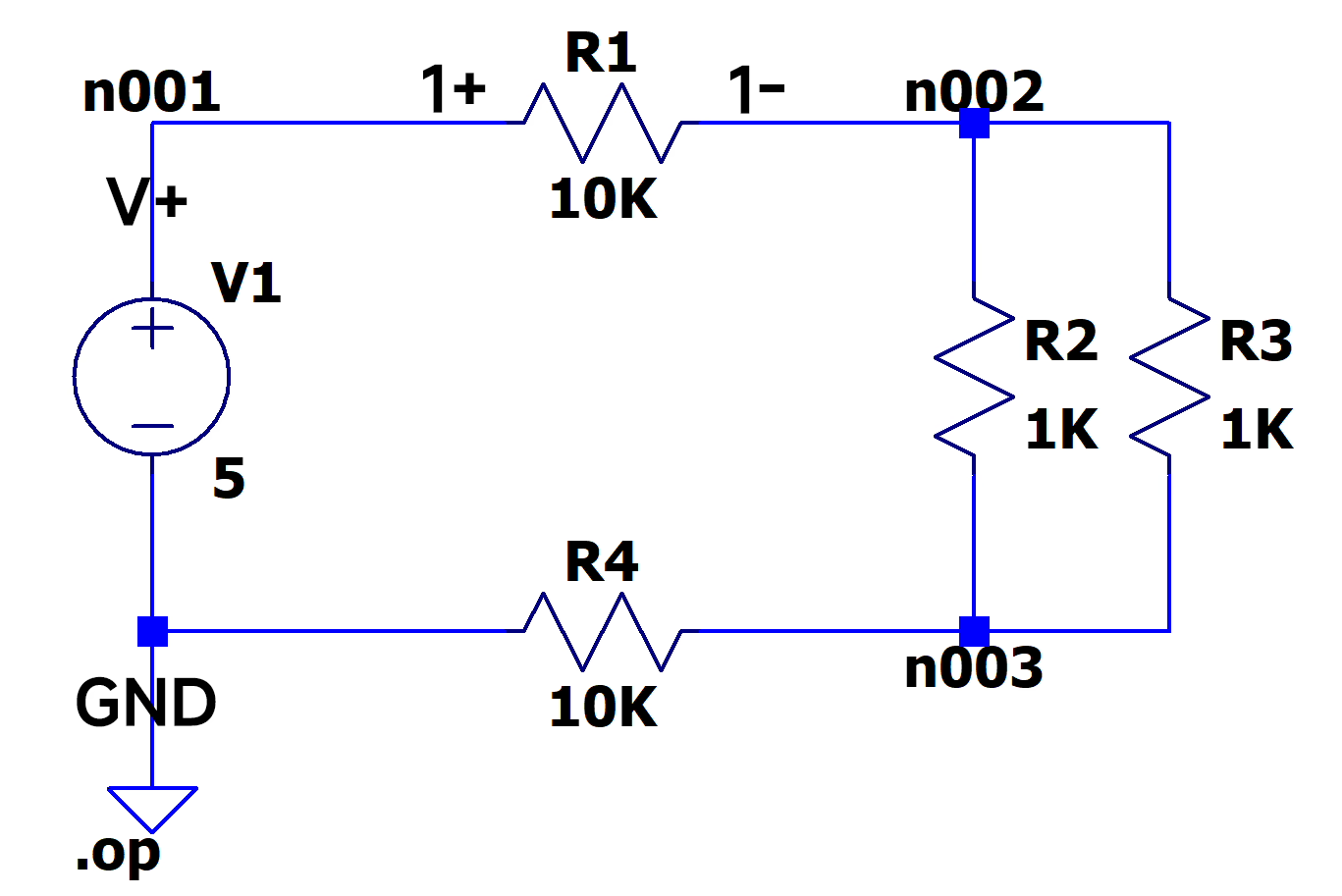
Description
- Based on the description of Ohm’s Law, the voltage is equal to current times resistance. So, I will check the real measurements with voltmeter and the theoretic values.
- Based on the description of KCL, the current goes into a node is equal to current goes out the node. So I am going to measure the currents and add them together to check if it matches the theory.
- Based on the description of KVL, the net voltage of nodes in the loop is equal to zero. So, I am going to measure all the voltage across the loop and check the sum.
Analysis
We know that, the Ohm’s Law, KCL, and KVL can be shown as these formulas:
Based on , the total should be
And should be
To find and , we can use
Based on , we should see , since is the current goes into node n002 and is the current goes out node n002.
Based on , we should expect , since they are in the same loop.
We will check if the experimental results fit these expectations.
Simulation
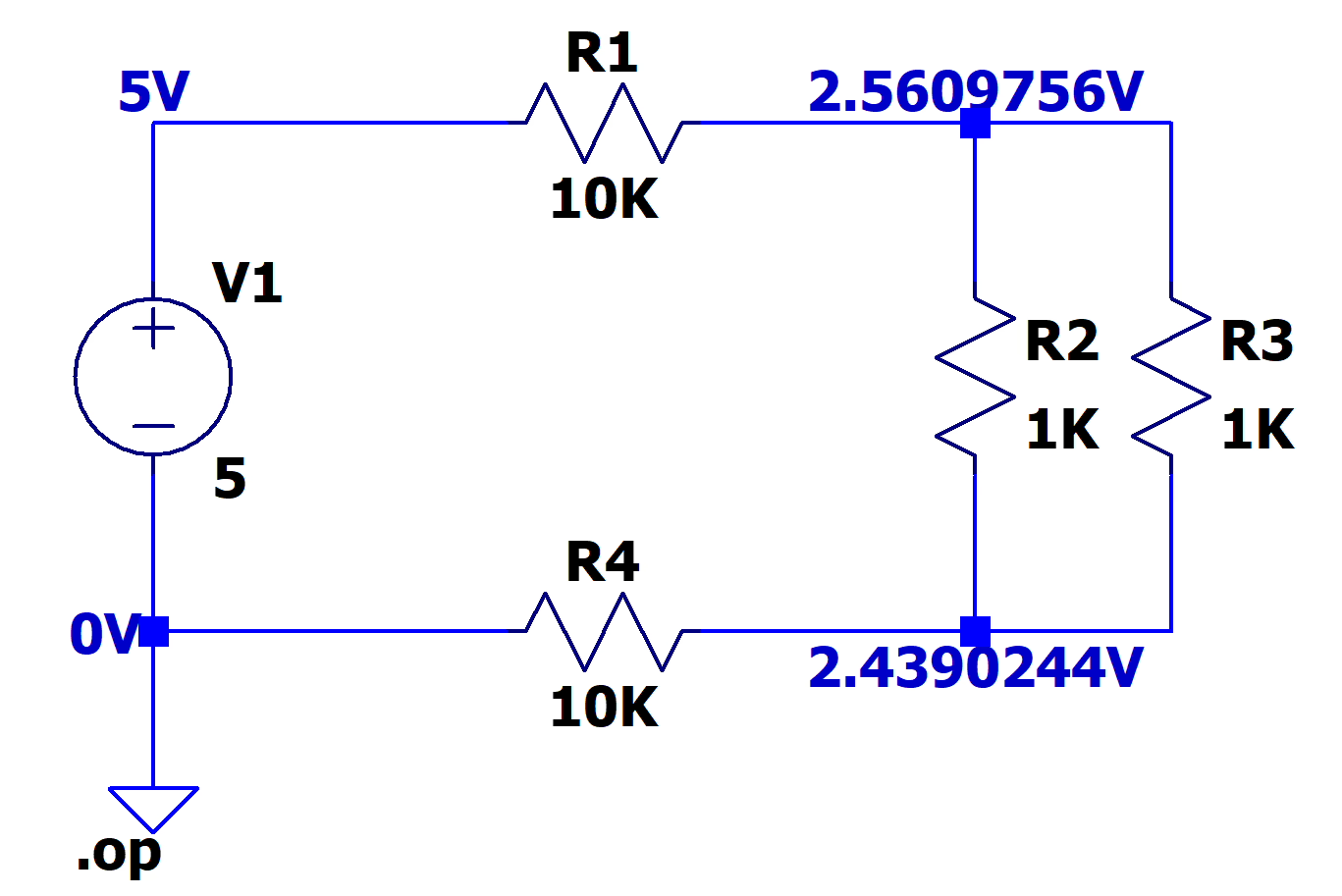
Proof of Concept - Omega Lab 01 - 1 - Simulation
|
|
Measurement
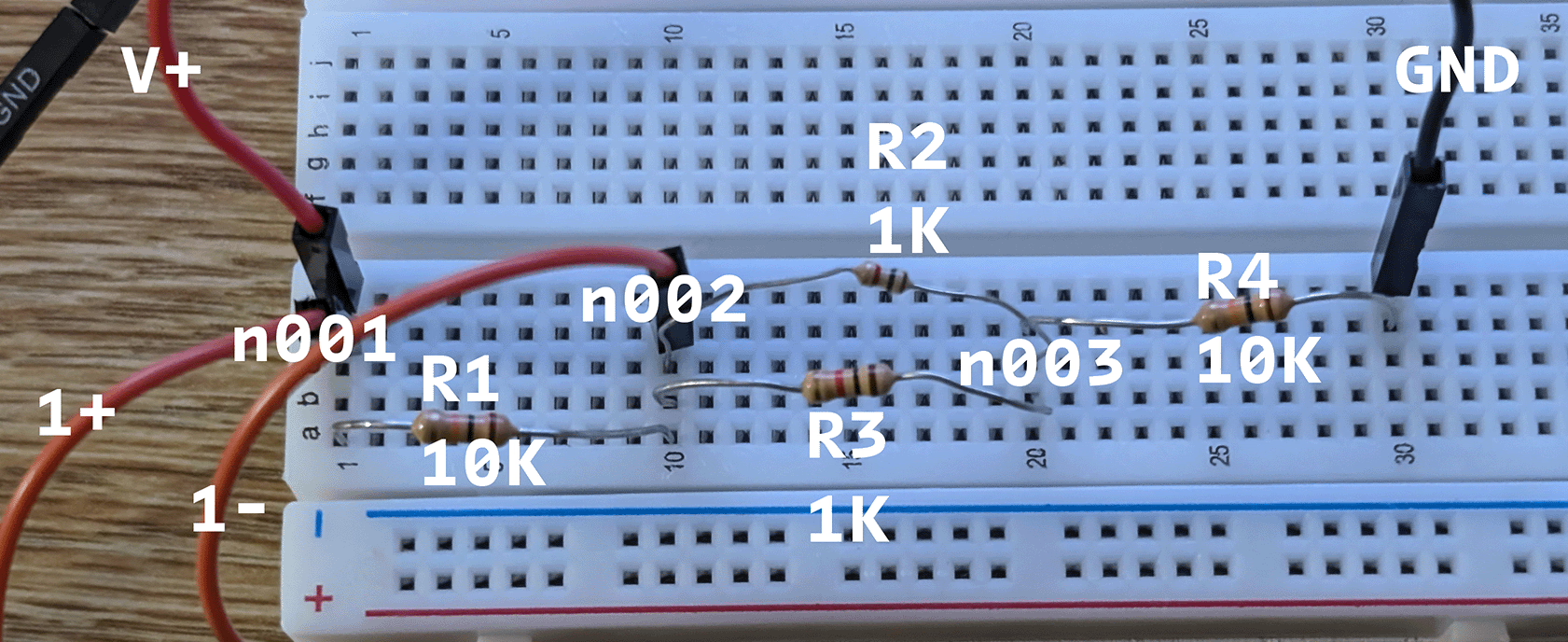
Proof of Concept - Omega Lab 01 - 1 - Measurement

Proof of Concept - Omega Lab 01 - 1 - Measurement - 1

Proof of Concept - Omega Lab 01 - 1 - Measurement - 2

Proof of Concept - Omega Lab 01 - 1 - Measurement - 3
Discussion
First, let’s compare the theoretical value with the experimental measurements.
We got the experimental reading from Analog Discovery 3.
|
|
To find out the theoretic values of , and . We need to do some math.
We know the simulation output is
|
|
and the voltage is the difference in potential. Based on that, we can calculate the theoretic values of , and .
Let’s make a table to compare the results
| Items | Analysis | Simulation | Experiment | diff | diff |
|---|---|---|---|---|---|
We can see that and are very accurate. But and has a lot of error. A potential explanation is that, there is a background noise.
If we look at the “Measurement”, channel 2 is empty, but it still has a reading around . It’s very likely to be a background noise. If we remove this noise from Experimental Measurements. The diff will be less than . Consider that the resistor has a Tolerance of (from 4 Band Resistor Color Code). We can consider this as systematic error and the Experimental Measurements is very close to Simulations.
Now, let’s check KCL.
We got the simulations data like
|
|
Using the expectation from Analysis. We can check
KCL is very likely be True.
Then, let’s check KVL.
We can use the result from previous part.
Use the expectation from Analysis. We can check
KVL is very likely be True.
Finally, let’s check Ohm’s Law. Using the expectation and the experimental data.
|
|
to calculate based on Ohm’s Law.
Then, we can check these current result with simulation data.
| Items | Analysis | Simulation | Experiment | diff | diff |
|---|---|---|---|---|---|
We can see that and are very accurate. But and has a lot of error. A potential explanation is that, there is a background noise.
If we look at the “Measurement”, channel 2 is empty, but it still has a reading around . It’s very likely to be a background noise. If we remove this noise from Experimental Measurements. The diff will be less than . Consider that the resistor has a Tolerance of (from 4 Band Resistor Color Code). We can consider this as systematic error and the Experimental Measurements is very close to Simulations.
Also, we can check to total current in the circuit. Using the expectation form “Analysis” - , this matches the simulation - .
In conclusion, the simulation 100% fit the KCL and KVL. The experimental data is close to the simulation. And very close to simulation if we remove the background noise and consider the tolerance of the resistor. Then, we used Ohm’s Law with experimental data to compare the simulation. The result is also very close. Thus, we proved Ohm’s Law, KCL, and KVL in a Circuit.
2. Prove the Concept of a Voltage Divider in a Series Circuit
Circuit Schematic
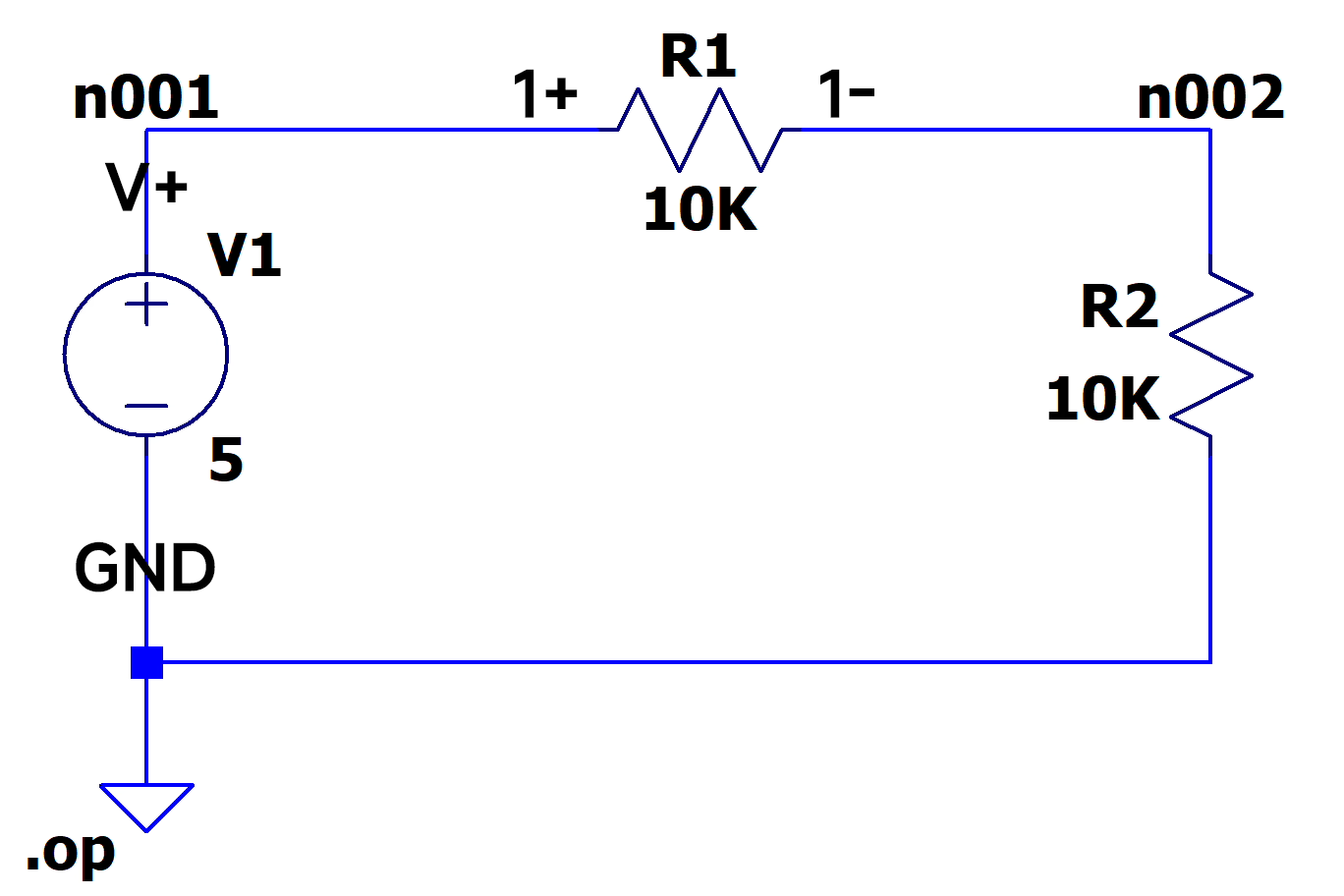
Proof of Concept - Omega Lab 01 - 2 - Schematic
Description
I am going to build a series circuit with two resistors and measure the voltage across the resistors to compare the theoretic values.
Analysis
The Voltage Divider equation is
If we have the voltage source and . Put the values into the equation and get
We know that and . So, we should expect .
Simulation
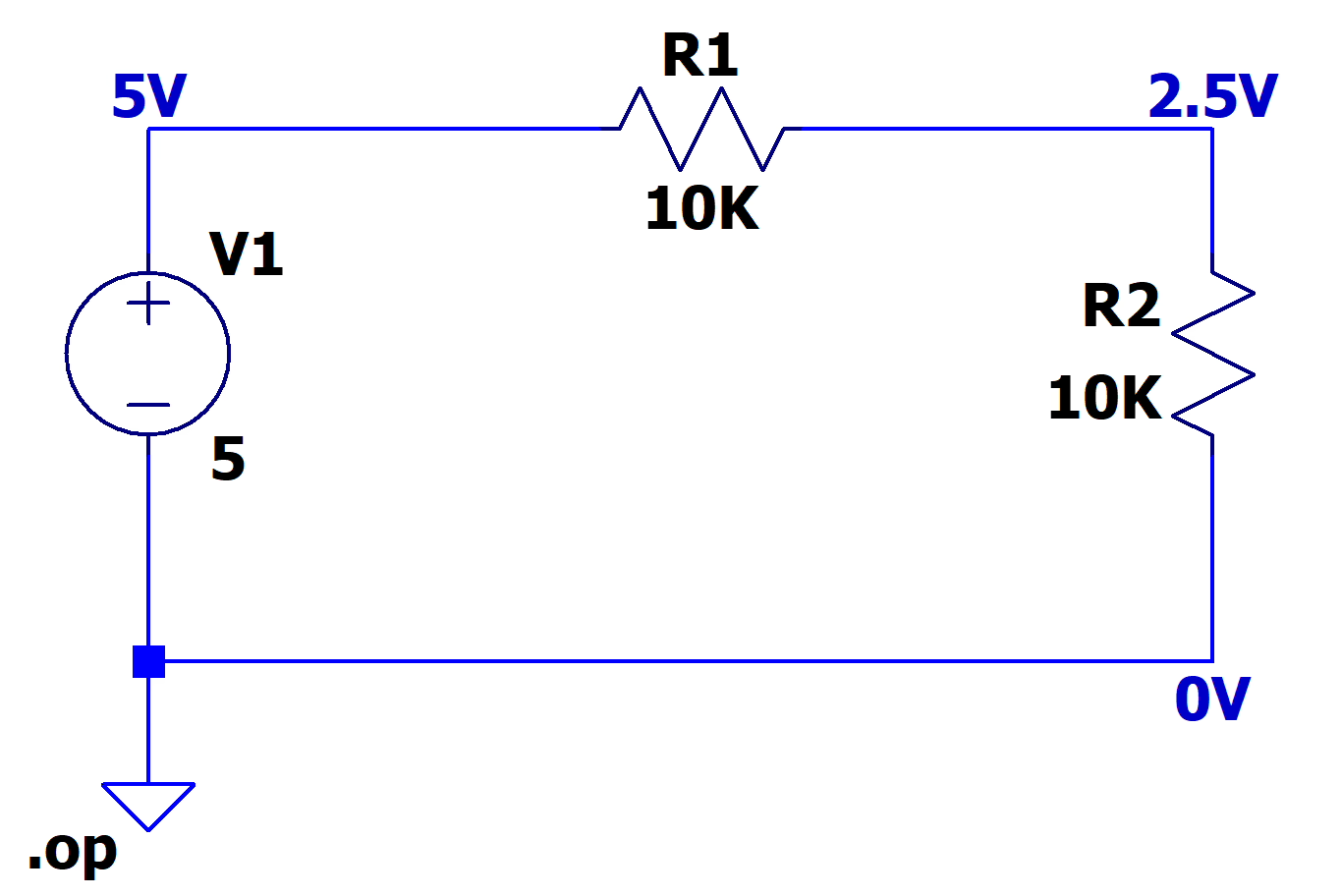
Proof of Concept - Omega Lab 01 - 2 - Simulation
|
|
Measurement
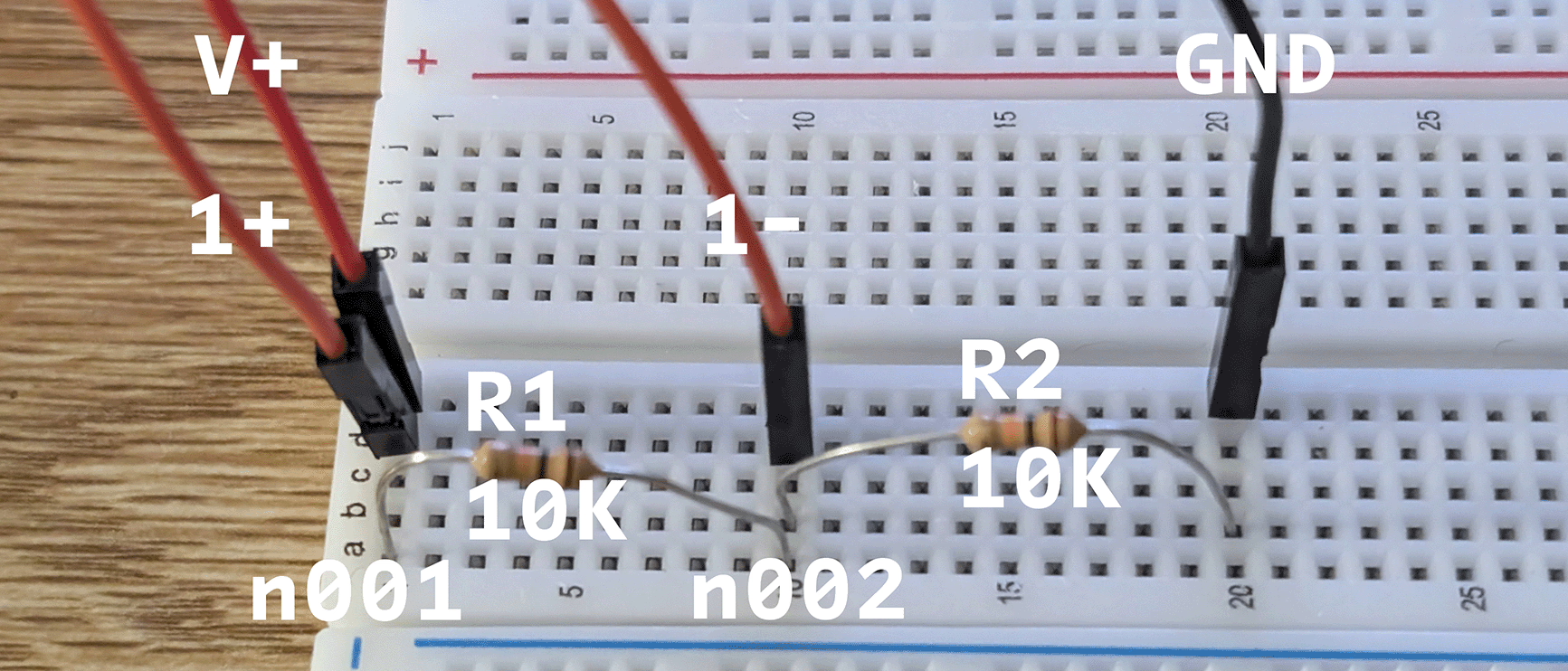
Proof of Concept - Omega Lab 01 - 2 - Measurement

Proof of Concept - Omega Lab 01 - 2 - Measurement - 1

Proof of Concept - Omega Lab 01 - 2 - Measurement - 2
Discussion
First, let’s compare the theoretical value with the experimental measurements.
We got the experimental reading from Analog Discovery 3.
|
|
and the voltage is the difference in potential. Based on that, we can calculate the theoretic values of and . We need to do some math.
We know the simulation output is
|
|
Let’s make a table to compare the results
| Items | Analysis | Simulation | Experiment | diff | diff |
|---|---|---|---|---|---|
We can see that both and are very accurate. They are some errors, A potential explanation is that, there is a background noise.
If we look at the “Measurement”, channel 2 is empty, but it still has a reading around . It’s very likely to be a background noise. If we remove this noise from Experimental Measurements. The diff will be less than . Consider that the resistor has a Tolerance of (from 4 Band Resistor Color Code). We can consider this as systematic error and the Experimental Measurements is very close to Simulations.
In conclusion, the simulation 100% fits the Voltage Divider theoretic formula. And the experimental reading is close to theoretic values. And the experimental reading is very close to theoretic values if we removed the background noise. Thus, we proved the Concept of a Voltage Divider in a Series Circuit.
3. Prove the Concept of How Current Flows in a Series Circuit
Circuit Schematic

Proof of Concept - Omega Lab 01 - 2 - Schematic
Description
I am going to use the Ohm’s Law to find out the current flows through every resistor in the series circuit and compare it with the theoretic values.
Analysis
The feature of series circuit is that
- There is only one path for the current to flow through the circuit.
- The current is the same at any point in the circuit.
Since Analog Discovery 3 can’t directly measures the current but the voltage. We are going to use Ohm’s Law to find out the current flow through the resistor.
We know this relationship from Ohm’s Law
We can change it a bit into
Also, we know that and the voltage across the resistor can be found by voltage divider formula. which is
We know that and . So, we should expect .
Using these values, we can find out and by
We expect and to be .
Simulation

Proof of Concept - Omega Lab 01 - 2 - Simulation
|
|
Measurement

Proof of Concept - Omega Lab 01 - 2 - Measurement

Proof of Concept - Omega Lab 01 - 2 - Measurement - 1

Proof of Concept - Omega Lab 01 - 2 - Measurement - 2
Discussion
From the Simulation Result,
|
|
It proves , which
- There is only one path for the current to flow through the circuit.
- The current is the same at any point in the circuit.
From the Measurement Result, we got the voltage across and
Based on the Ohm’s Law - the relationship we got in Analysis . We can find and by
Both and are very close, we can say that . Consider that the resistor has a Tolerance of (from 4 Band Resistor Color Code). We can consider this as systematic error and the Experimental Measurements is very close to Simulations.
In conclusion, the simulation 100% fits the feature of current in series circuit. And the experimental reading is close to theoretic values. And the experimental reading is very close to theoretic values if we consider that the resistor has a Tolerance of (from 4 Band Resistor Color Code). Thus, we proved the Concept of How Current Flows in a Series Circuit.
- There is only one path for the current to flow through the circuit.
- The current is the same at any point in the circuit.
4. Prove the Concept of Voltage Across a Parallel Circuit
Circuit Schematic
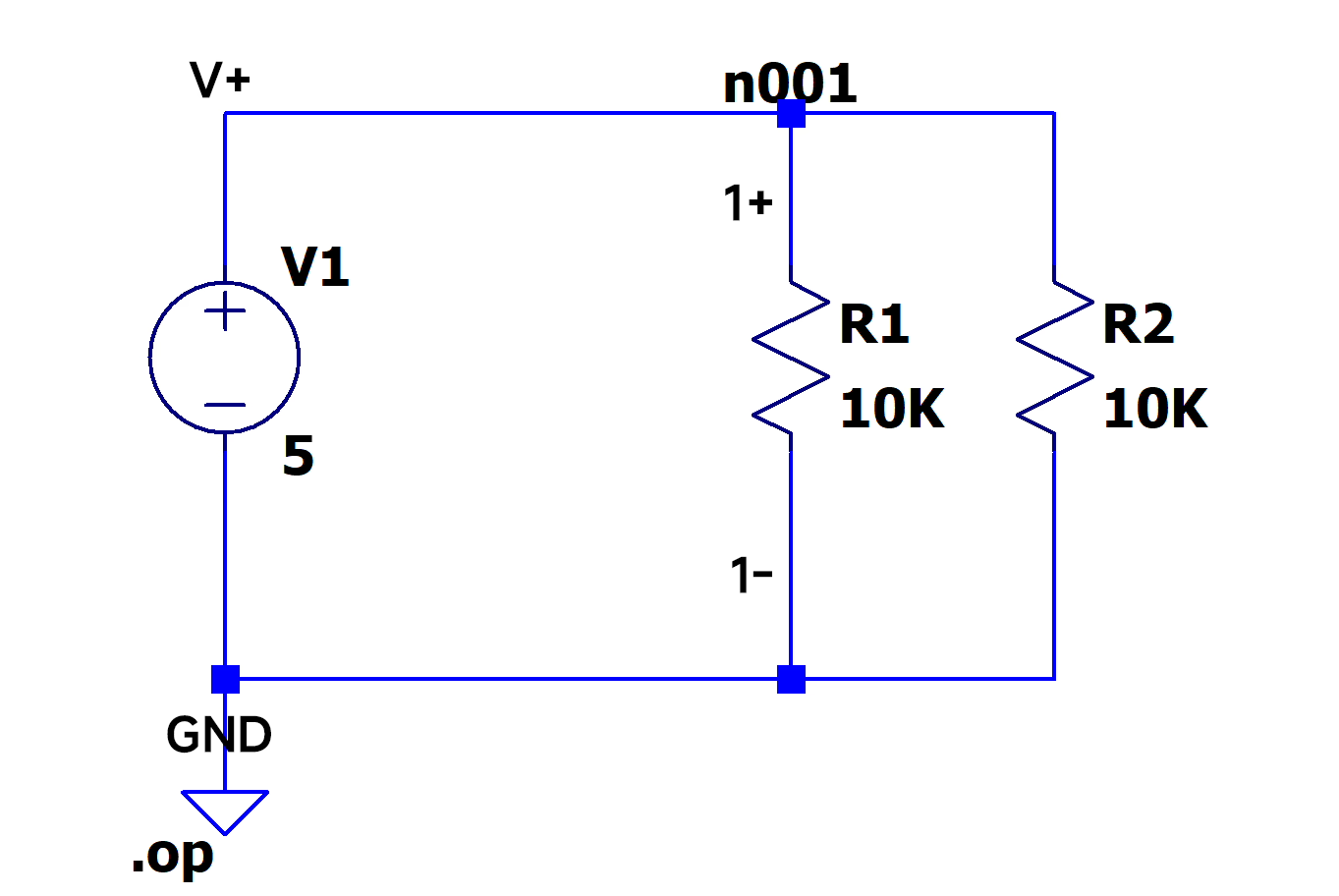
Proof of Concept - Omega Lab 01 - 4 - Schematic
Description
I am going to use the Ohm’s Law and feature of node to find out the voltage across every resistor in the parallel circuit and compare it with the theoretic values.
Analysis
The feature of parallel circuit is that
- There are multiple paths for the current to flow through the circuit.
- The voltage across each branch is the same and equal to the voltage supplied by the source.
We know that the voltage in the same node is the same (they are connected by a wire). And n001, n002 connected both side of resistor. So, we should expect .
Also, the voltage is potential difference between the component.
Also, we can check the current of this circuit. We know that the current in a parallel circuit is
and from Ohm’s Law, we know that
We can change it a bit into
And, we know that the resistance in parallel is
So,
Combine them together, we got
Let’s put values into equation
We can check this to double confirm our result.
Simulation
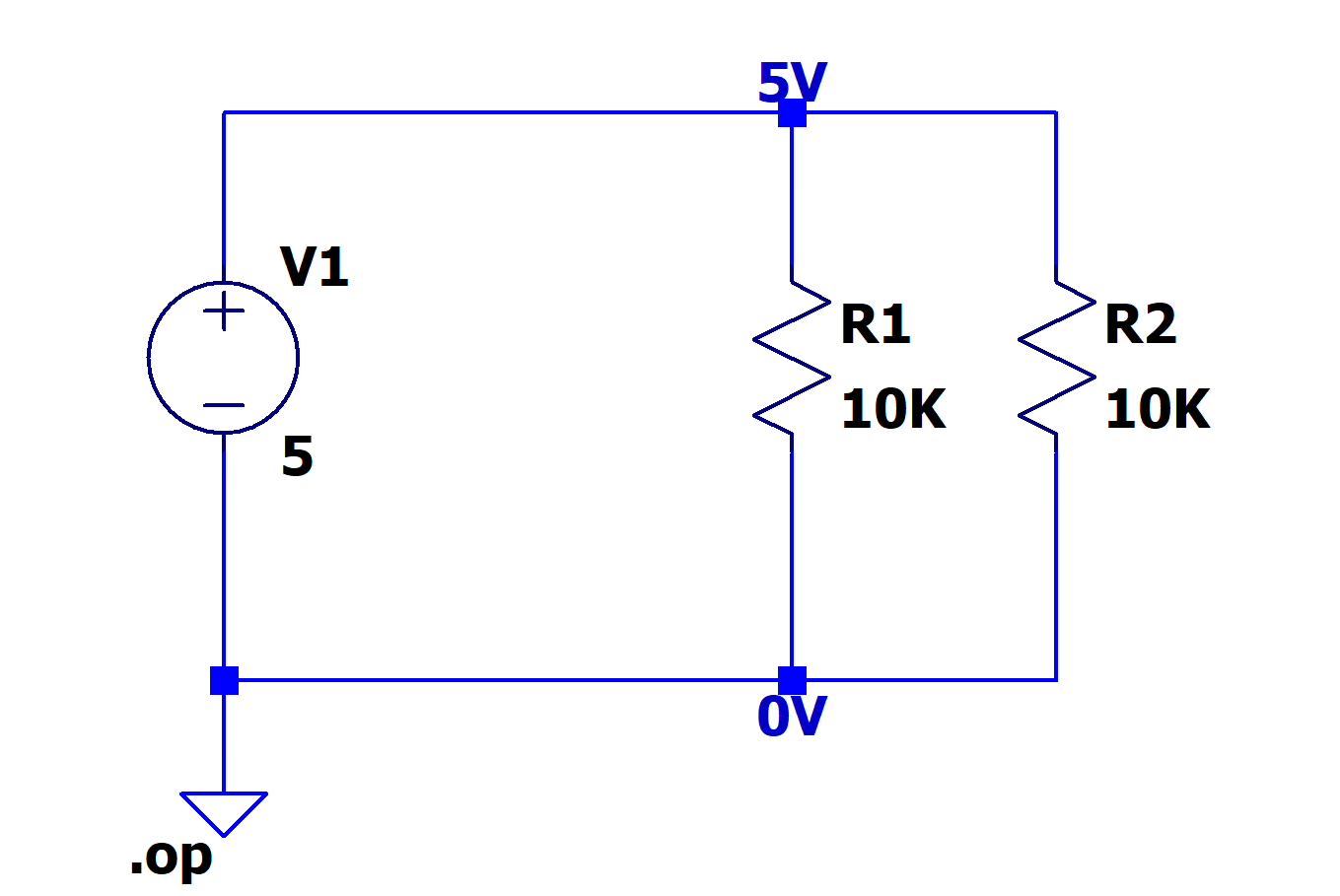
Proof of Concept - Omega Lab 01 - 4 - Simulation
|
|
Measurement
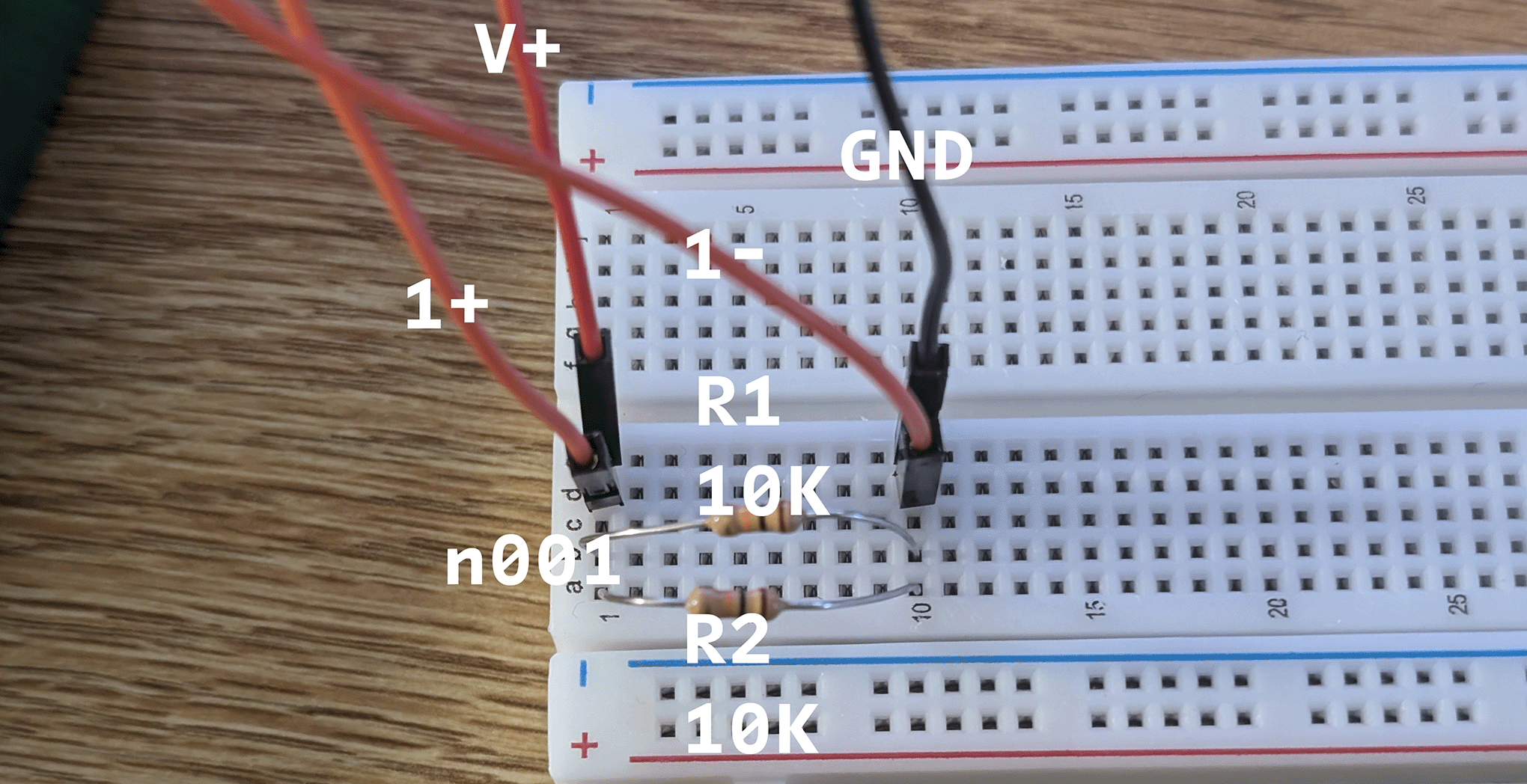
Proof of Concept - Omega Lab 01 - 4 - Measurement

Proof of Concept - Omega Lab 01 - 4 - Measurement - 1
Discussion
First, let’s compare the theoretical value with the experimental measurements.
We got the experimental reading from Analog Discovery 3.
|
|
To find out the theoretic values of and . We need to do some math.
We know the simulation output is
|
|
and the voltage is the difference in potential. Based on that, we can caculate the theoretic values of and .
Let’s make a table to compare the results
| Items | Analysis | Simulation | Experiment | diff | diff |
|---|---|---|---|---|---|
We can see that both and are very accurate. They are some errors, A potential explanation is that, there is a background noise.
If we look at the “Measurement”, channel 2 is empty, but it still has a reading around . It’s very likely to be a background noise. If we remove this noise from Experimental Measurements. The diff will be less than . Consider that the resistor has a Tolerance of (from 4 Band Resistor Color Code). We can consider this as systematic error and the Experimental Measurements is very close to Simulations.
Secondly, we can check to as double confirm.
We know the simulation output is
|
|
and from Analysis, we expect
We know that, the of a parallel circuit is
So, we get
Our Analysis matches Simulation.
Additionally, we can check the experimental data as well. Since Analog Discovery 3 can’t measure the current directly, we need use Ohm’s Law to find out current.
We got
|
|
and we know that
|
|
Then, we can find out and by
with only diff (even less then if we remove background noise). Our theory is very likely be true. Since the resistor has a Tolerance of (from 4 Band Resistor Color Code). We can consider this as systematic error and the Experimental Measurements is very close to Simulations.
In conclusion, we checked the simulation 100% fit the Analysis’ expectation. And the experimental data only has to than the theoretic values. Thus, we proved Concept of Voltage Across a Parallel Circuit.
- There are multiple paths for the current to flow through the circuit.
- The voltage across each branch is the same and equal to the voltage supplied by the source.
5. Prove the Concept of a Current Divider in a Parallel Circuit
Circuit Schematic

Proof of Concept - Omega Lab 01 - 4 - Schematic
Description
I am going to use the Ohm’s Law to find out the current across every resistor in the parallel circuit and compare its sum with the theoretic values.
Analysis
The feature of parallel circuit is that
- There are multiple paths for the current to flow through the circuit.
- The voltage across each branch is the same and equal to the voltage supplied by the source.
- The total current entering the parallel circuit is divided among the branches.
We know that the voltage in the same node is the same (they are connected by a wire). And n001, n002 connected both side of resistor. So, we should expect .
Also, the voltage is potential difference between the component.
and from Ohm’s Law, we know that
We can change it a bit into
and get
the relationship between and can be express as
In our case, , so
as we get the by
As
We can get and by
At this point, our logic is consistent, which
The result of also got cross checked by . So, we are very confident that
For any current of the resistor in parallel circuit (e.g )
Simulation

Proof of Concept - Omega Lab 01 - 4 - Simulation
|
|
Measurement

Proof of Concept - Omega Lab 01 - 4 - Measurement

Proof of Concept - Omega Lab 01 - 4 - Measurement - 1
Discussion
First, let’s compare the theoretical value with the experimental measurements.
We got the experimental reading from Analog Discovery 3.
|
|
To find out the theoretic values of and . We need to do some math.
We know the simulation output is
|
|
and the voltage is the difference in potential. Based on that, we can calculate the theoretic values of and .
Let’s make a table to compare the results
| Iteams | Analysis | Simulation | Experiement | diff | diff |
|---|---|---|---|---|---|
We can see that both and are very accurate. They are some errors, A potential explanation is that, there is a background noise.
If we look at the “Measurement”, channel 2 is empty, but it still has a reading around . It’s very likely to be a background noise. If we remove this noise from Experimental Measurements. The diff will be less than . Consider that the resistor has a Tolerance of (from 4 Band Resistor Color Code). We can consider this as systematic error and the Experimental Measurements is very close to Simulations.
Second, let’s check and with theoretical values.
Since Analog Discovery 3 can’t measure the current directly, we need use Ohm’s Law to find out current.
We got
|
|
and we know that
|
|
Then, we can find out and by
| Items | Analysis | Simulation | Experiment | diff | diff |
|---|---|---|---|---|---|
We can see that both and are very accurate. They are some errors, A potential explanation is that, there is a background noise.
If we look at the “Measurement”, channel 2 is empty, but it still has a reading around . It’s very likely to be a background noise. If we remove this noise from Experimental Measurements. The diff will be less than . Consider that the resistor has a Tolerance of (from 4 Band Resistor Color Code). We can consider this as systematic error and the Experimental Measurements is very close to Simulations.
In conclusion, we checked the simulation 100% fit the Analysis’ expectation. And the experimental data only has to than the theoretic values. Thus, we proved Concept of How Current Flows in a Series Circuit.
- There are multiple paths for the current to flow through the circuit.
- The voltage across each branch is the same and equal to the voltage supplied by the source.
- The total current entering the parallel circuit is divided among the branches.
6. Prove the Concept of a Voltage Divider in Temperature Sensing Circuit
Circuit Schematic

Proof of Concept - Omega Lab 01 - 6 - Schematic
Description
We are going to use NTC 100K as our thermistor, and we will compare the reading with our thermometer and simulation to check its reliability.
Analysis
NTC thermistor uses Beta formula to calculate the resistance under a specific temperature. The formula is like
We can move to the left side to get
Since we want to find out the resistance of this thermistor under a specific temperature.
The thermistor we are using is NTC 100K. Which means it has at the reference temperature
Also, we got the value from the manufacturer, which
We know the Voltage Divider
put them together, we got
Simulation
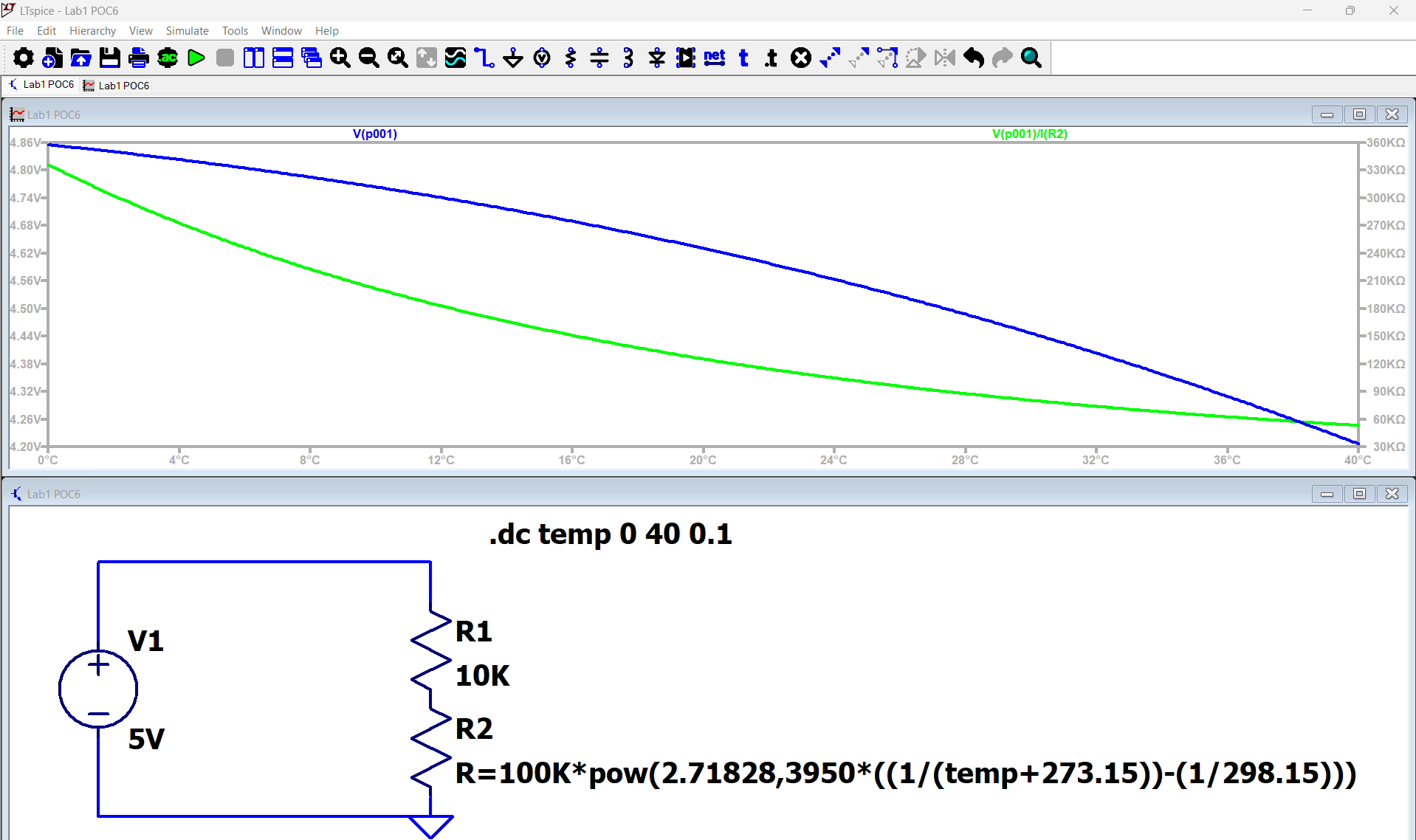
Proof of Concept - Omega Lab 01 - 6 - Simulation
We got a curve shows the relationship between the temperature and resistance in range of to
For , should be
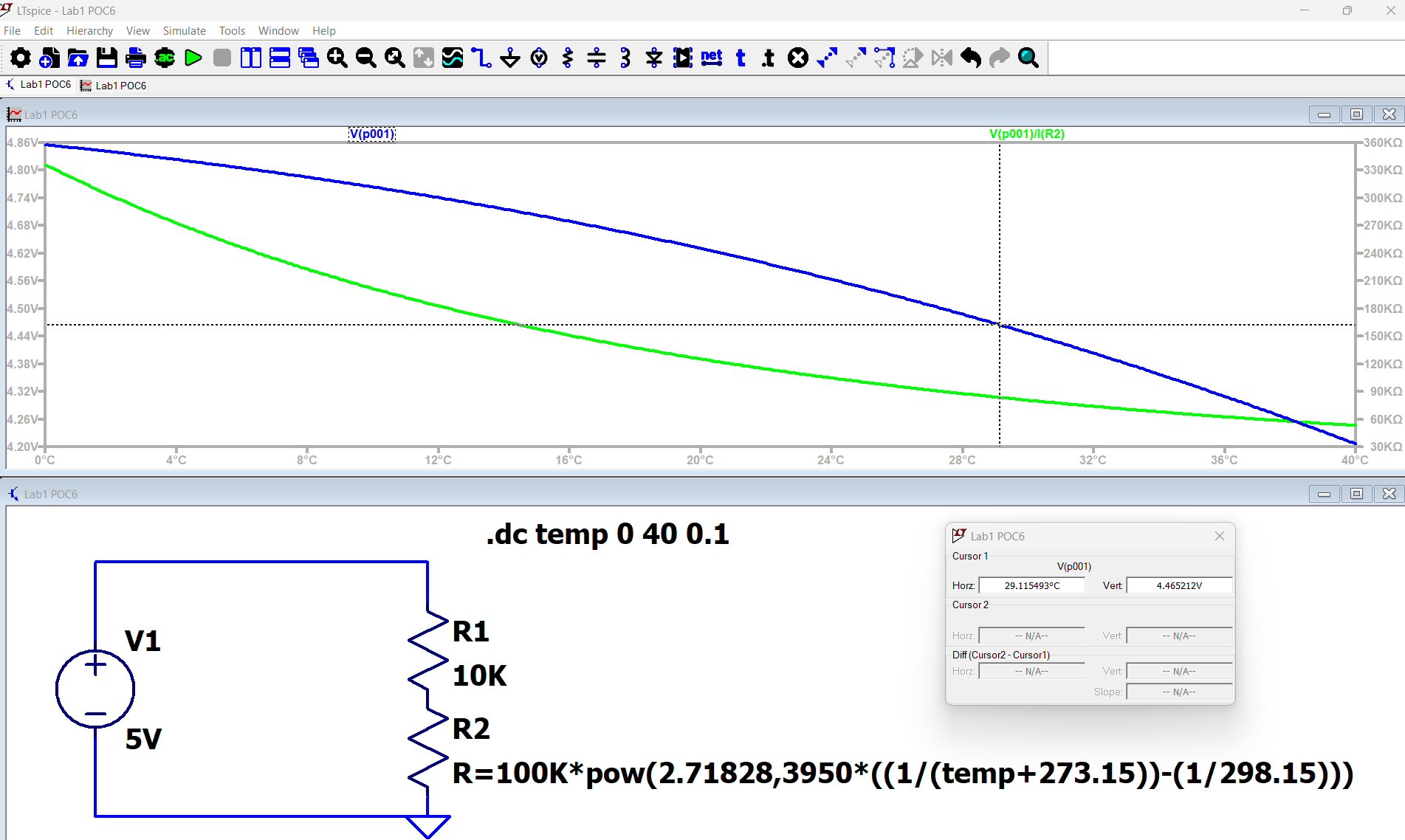
Proof of Concept - Omega Lab 01 - 6 - Simulation - 1
For , should be
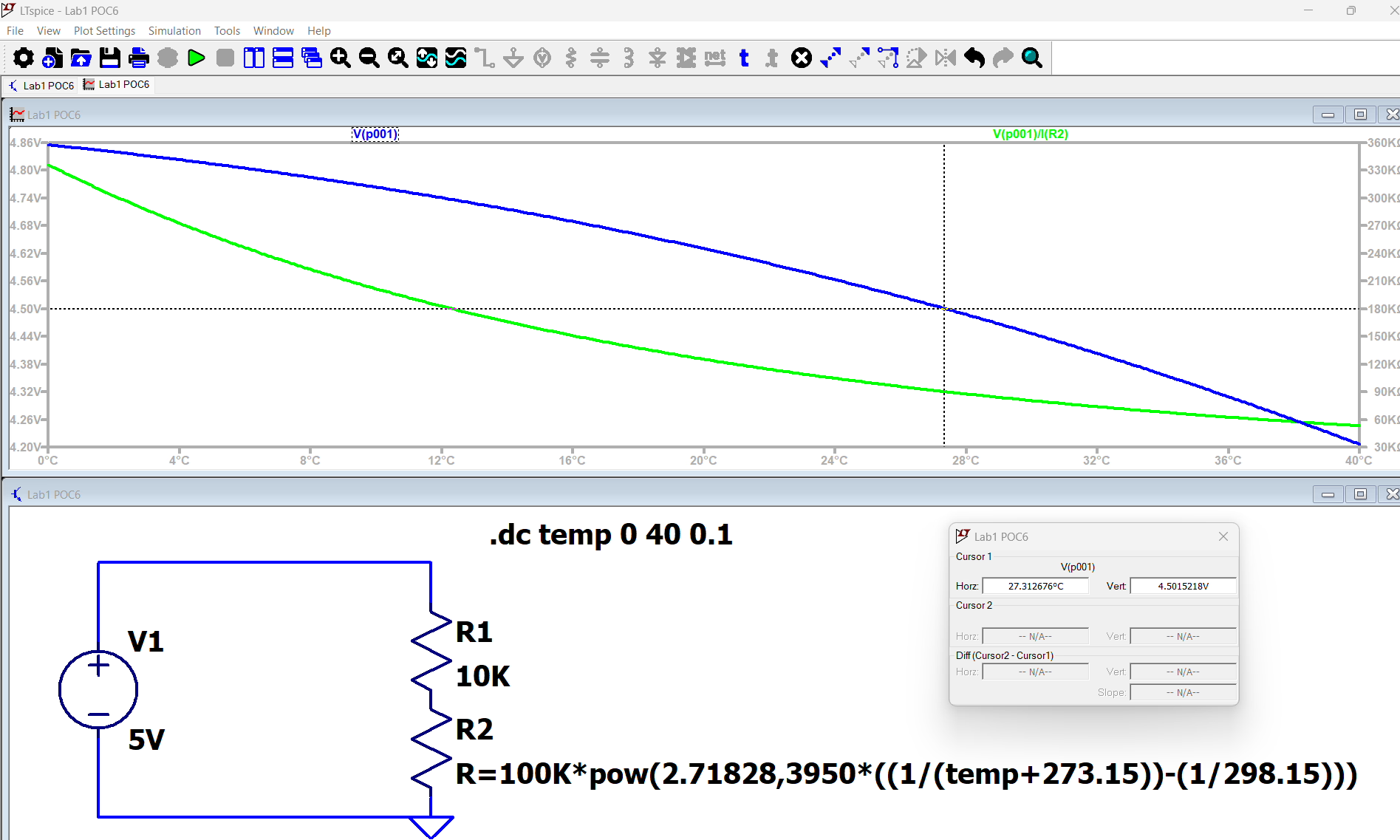
Proof of Concept - Omega Lab 01 - 6 - Simulation - 2
For , should be
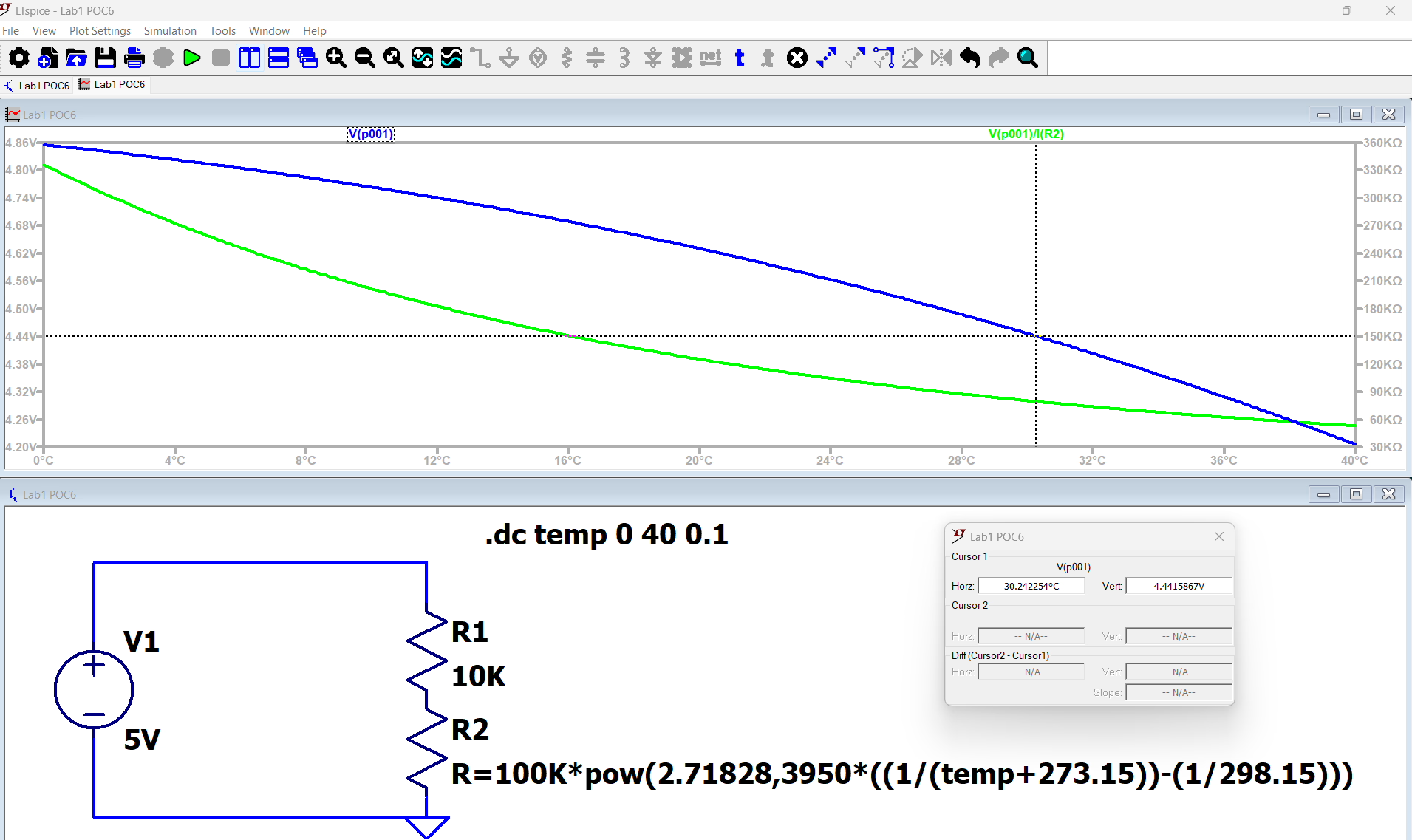
Proof of Concept - Omega Lab 01 - 6 - Simulation - 3
Measurement
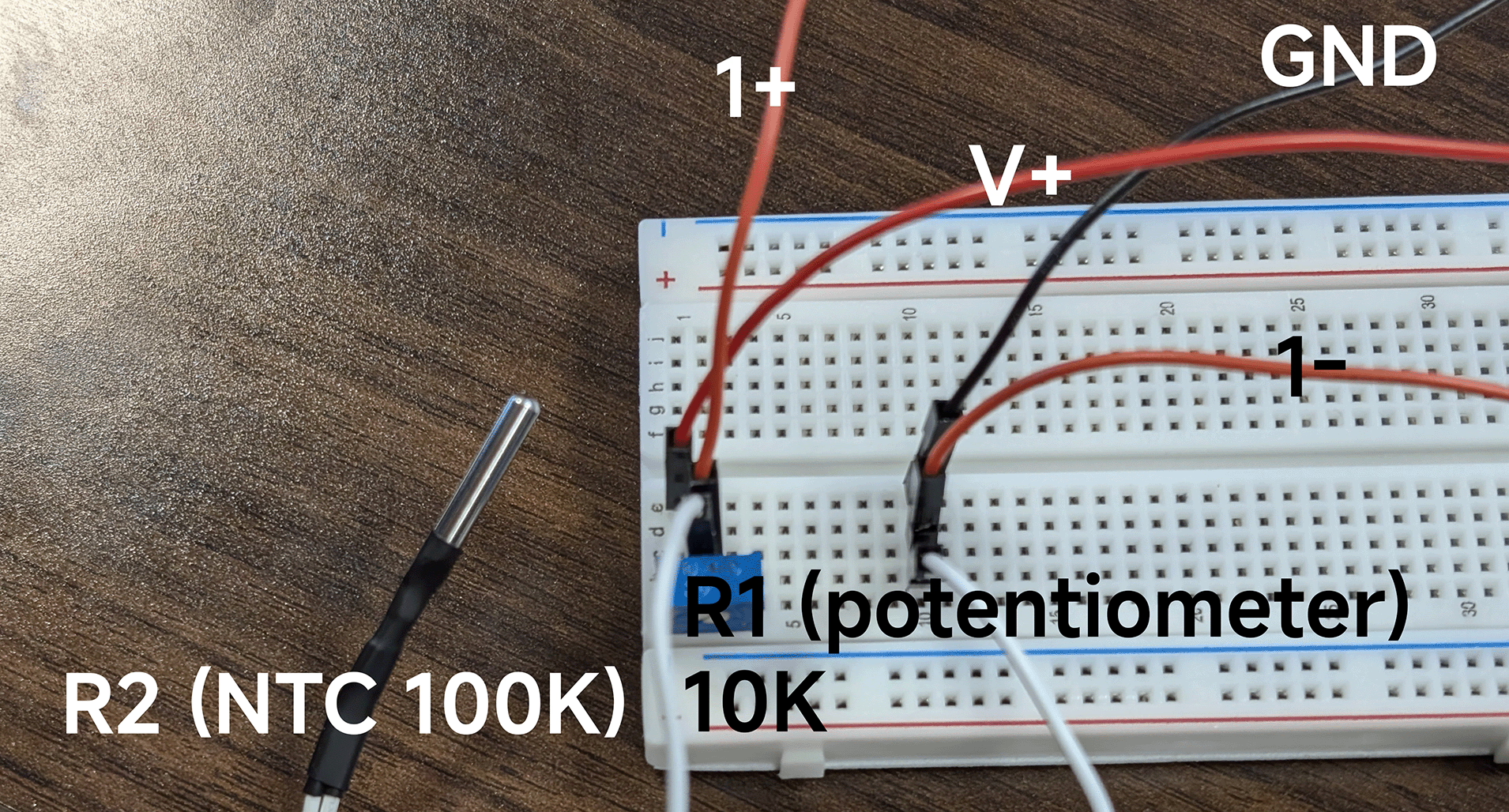
Proof of Concept - Omega Lab 01 - 6 - Measurement
We used the math function in Scope with
|
|
to get the temperature in . This is from
which is the temperature reading we want.
Then, we calibrate the thermistor with another thermometer at .
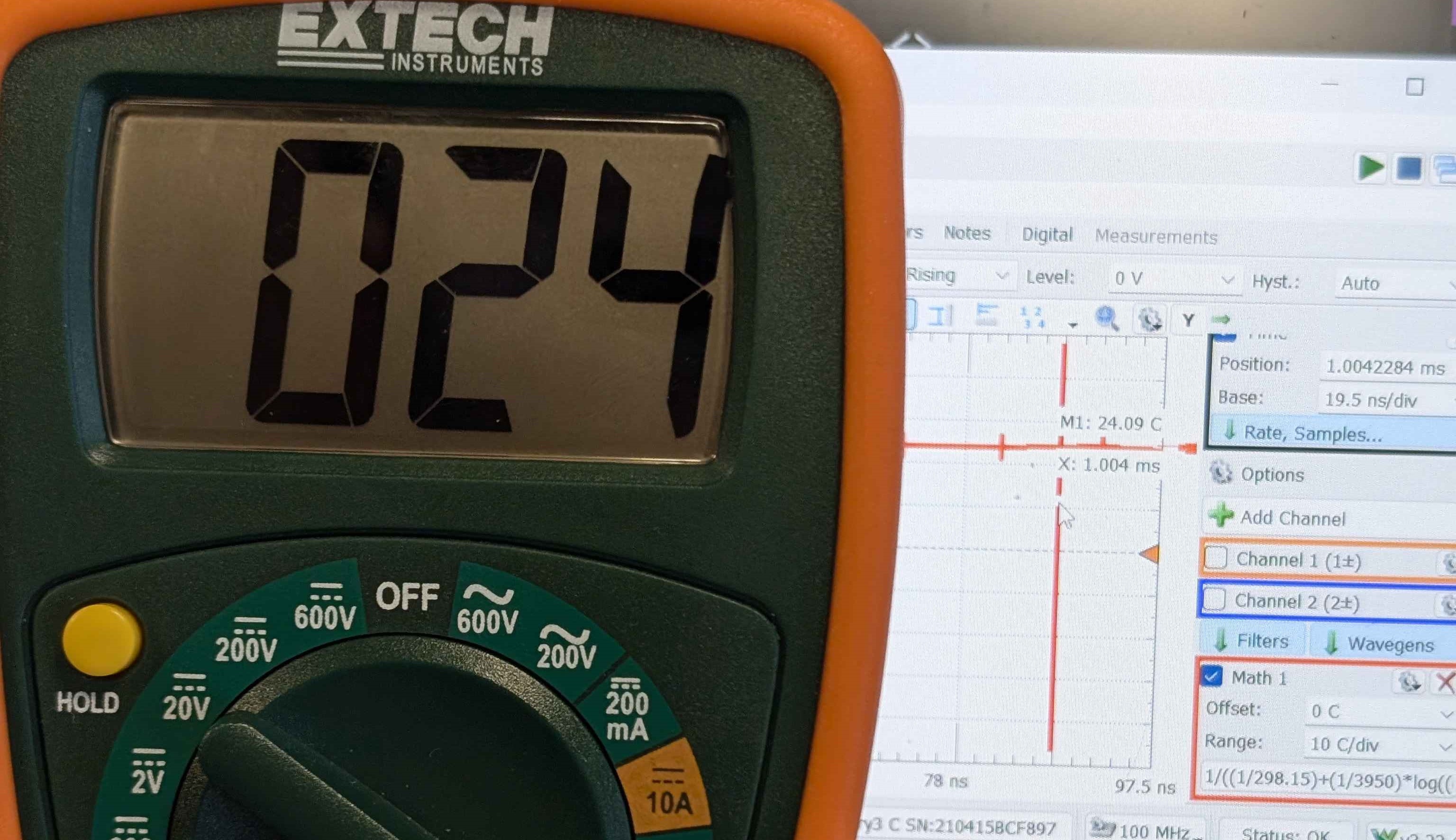
Proof of Concept - Omega Lab 01 - 6 - Measurement - 2
Later on, we toke three more reading

Proof of Concept - Omega Lab 01 - 6 - Measurement - 1

Proof of Concept - Omega Lab 01 - 6 - Measurement - 3

Proof of Concept - Omega Lab 01 - 6 - Measurement - 4
Discussion
| Temp | Analysis | Simulation | Experiement | diff | diff |
|---|---|---|---|---|---|
As we can see, the difference between theory and measurements is extremely small. This may due to the temperature reading is calculated from voltage by Math.
But even we look the thermometer’s reading, both of them shows around . In the worst case, the error is . So, over all, our reading is reliable.
The wheatstone bridge is better than a normal voltage divider because it is more sensitive than a voltage divider. A voltage divider relies on the ratio of resistances between two resistors, so even if the ratio of the resistors change, as long as the change isn’t massive, the output voltage stays the same.
When a wheatstone bridge is balanced, meaning R1/R2=R3/R4, the current flowing through the galvanometer in the center of the wheatstone bridge is 0. When current is zero, the calculated resistance is no longer affected by innate resistance of wires, resistors, and voltameters. This allows measurements with the wheatstone bridge to be more accurate than a voltage divider.
Advantages:
- Wheatstone bridge is more accurate than voltage divider
- Voltage source does not need to be calibrated to measure resistance
Disadvantages:
- Voltage divider is easier and cheaper to make
- Lower power consumption
Related Content
- CSCI 1100 - Homework 8 - Bears, Berries, and Tourists Redux - Classes
- CSCI 1100 - Homework 7 - Dictionaries
- Reverse Engineering DSAS Engage's API to Get CCA Information
- CSCI 1100 - Homework 6 - Files, Sets and Document Analysis
- CSCI 1100 - Test 3 Overview and Practice Questions